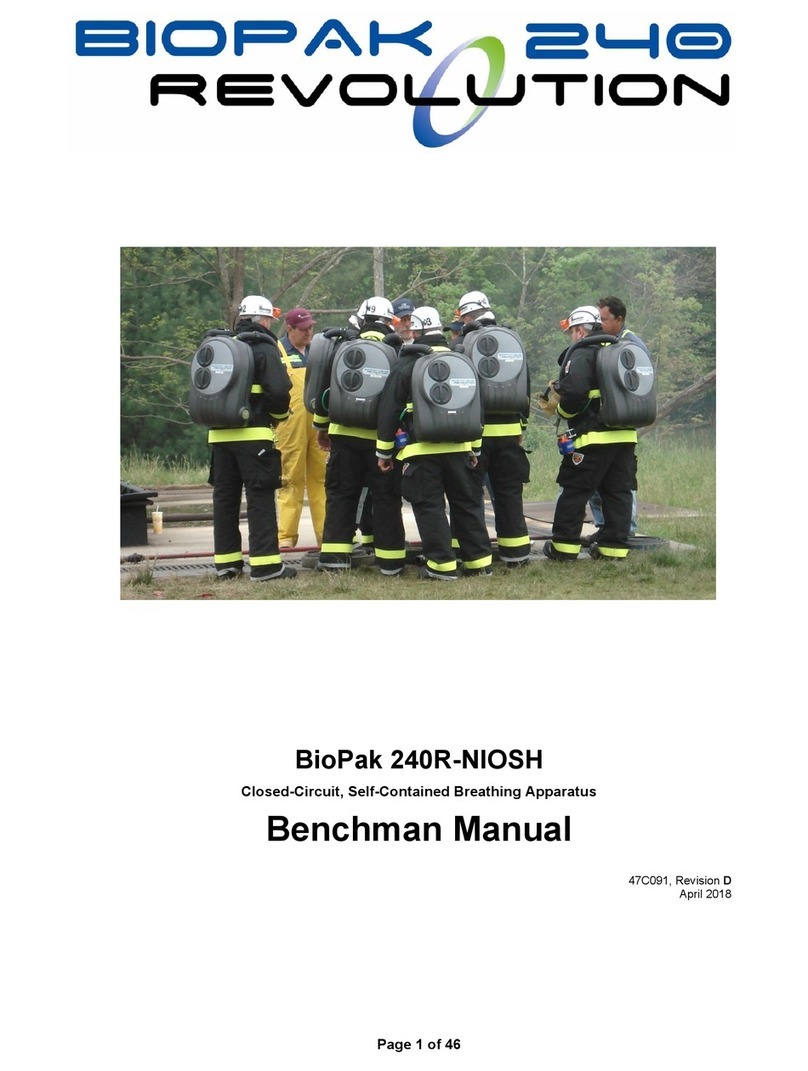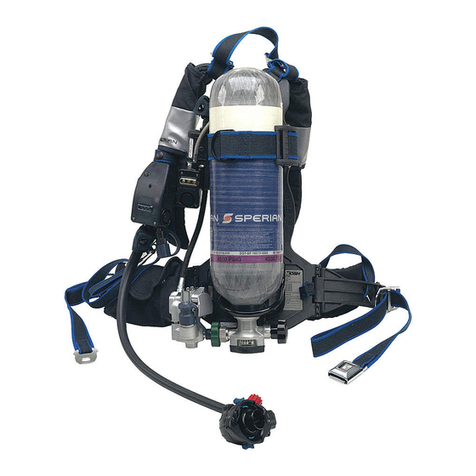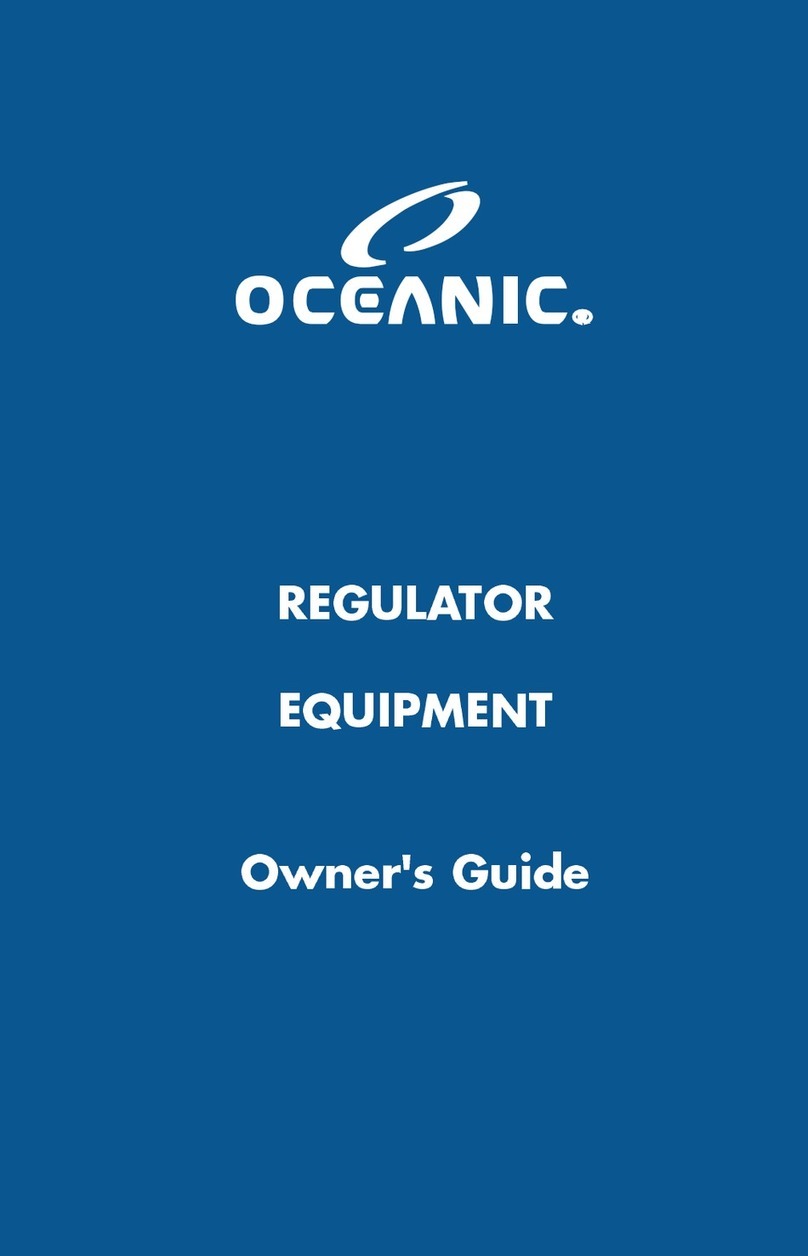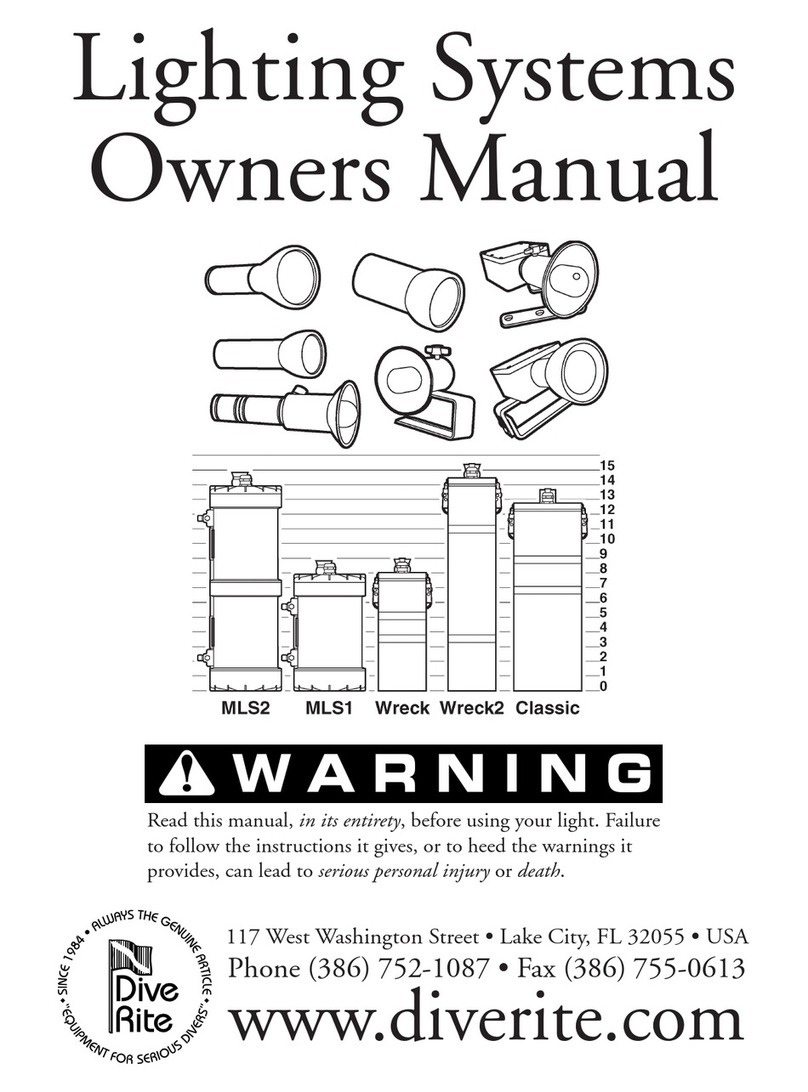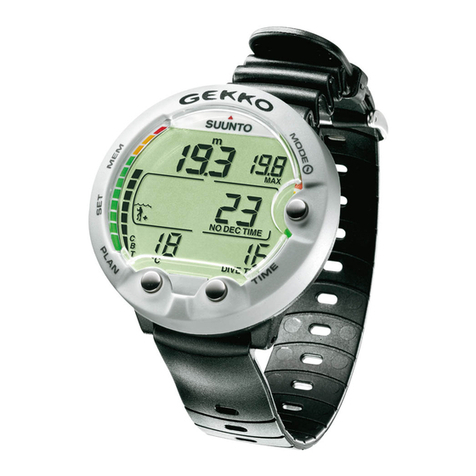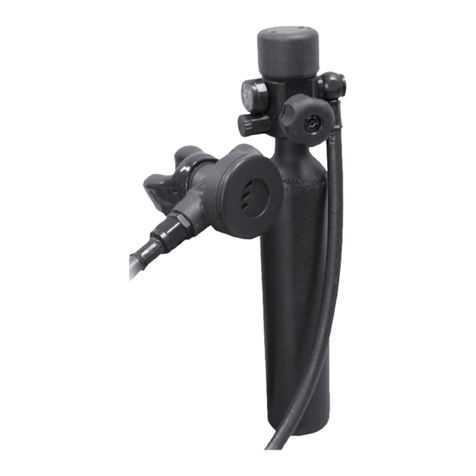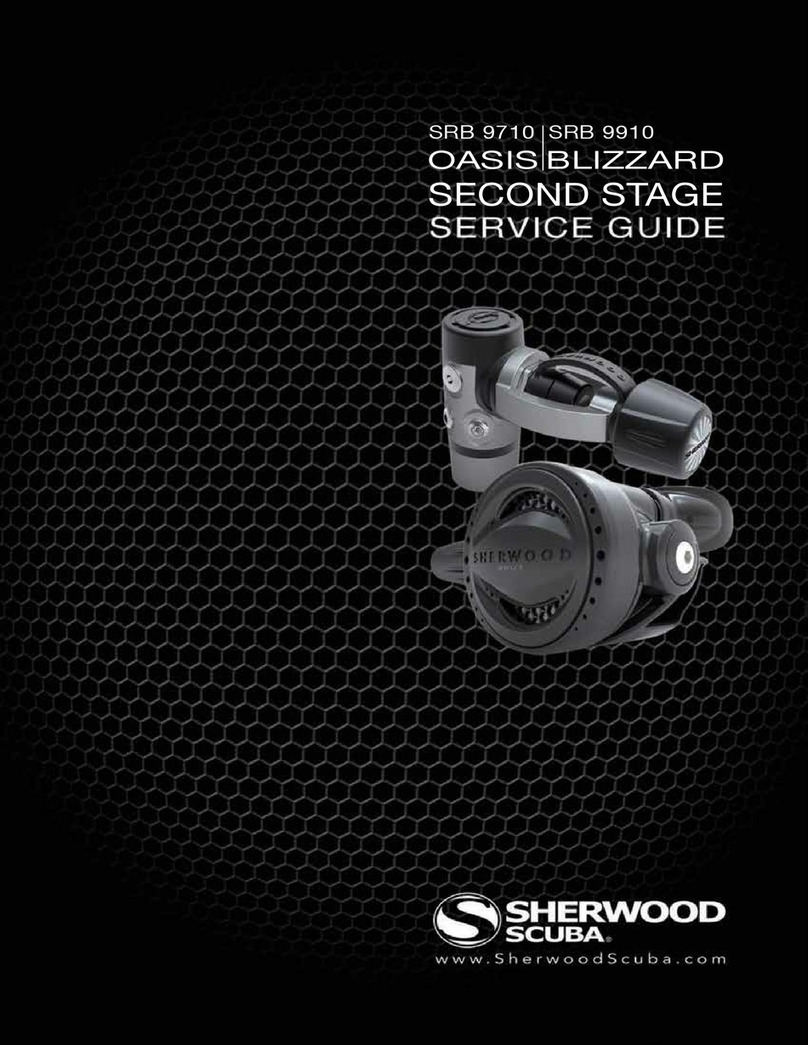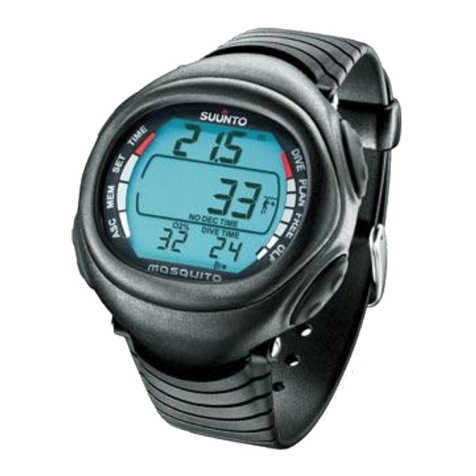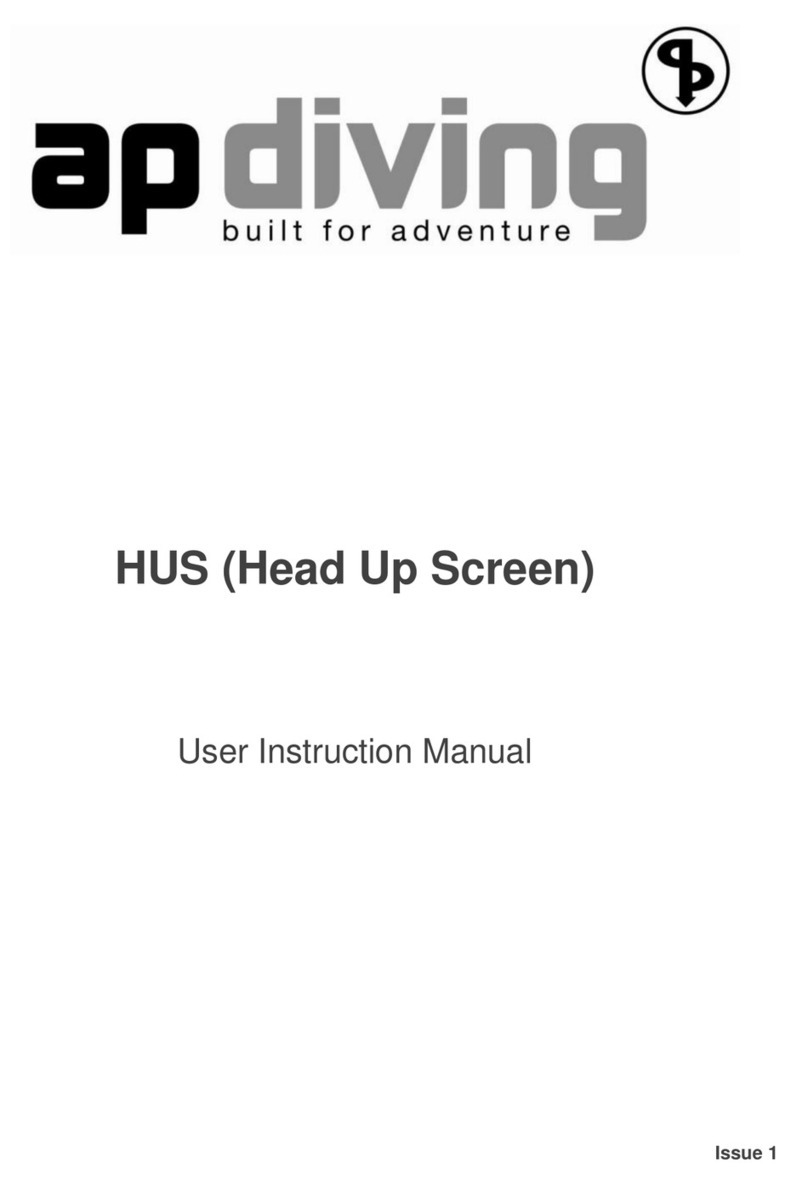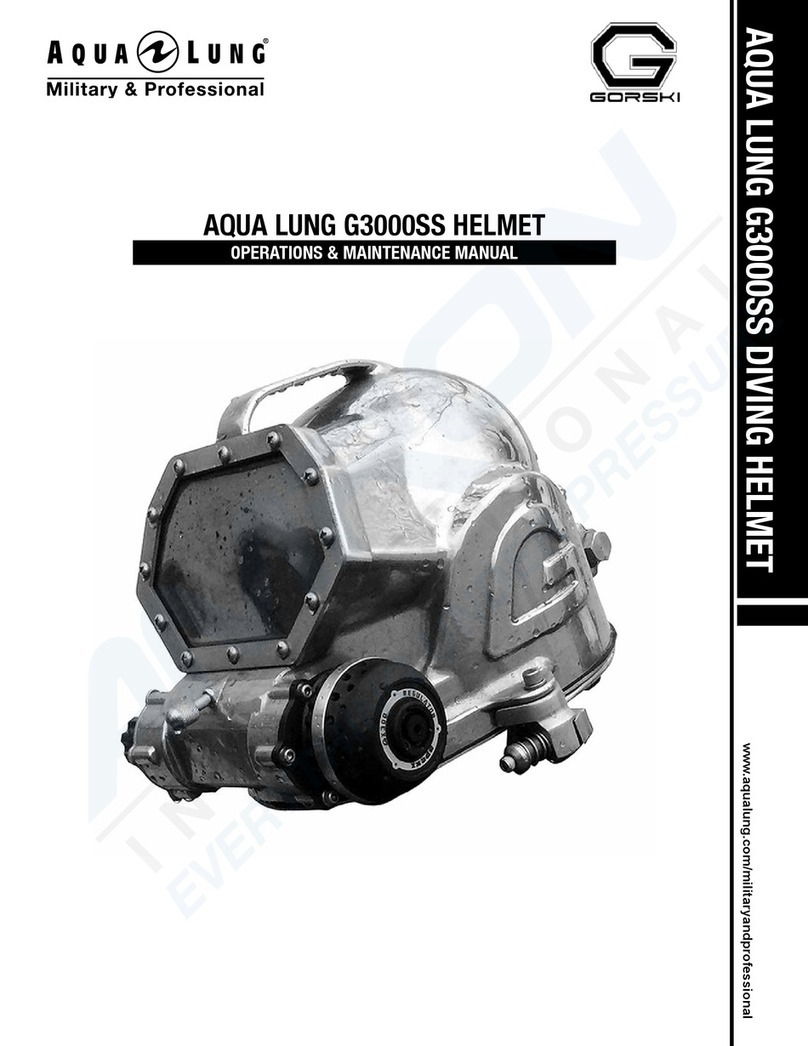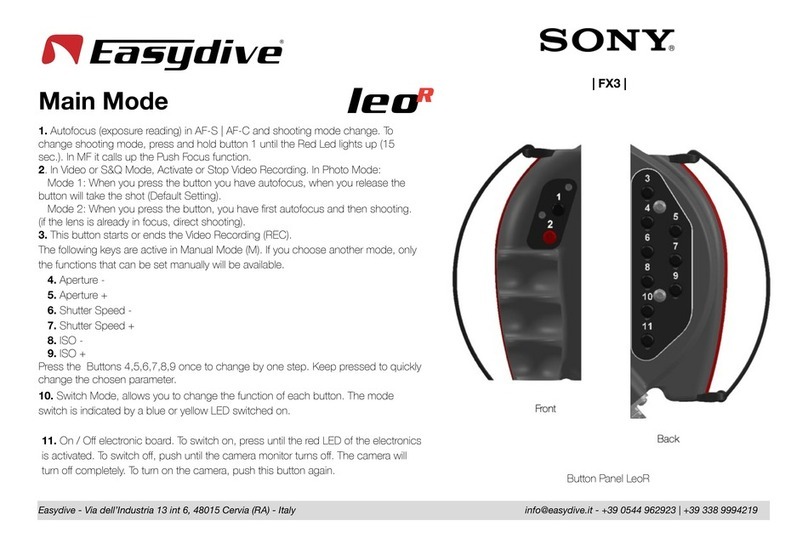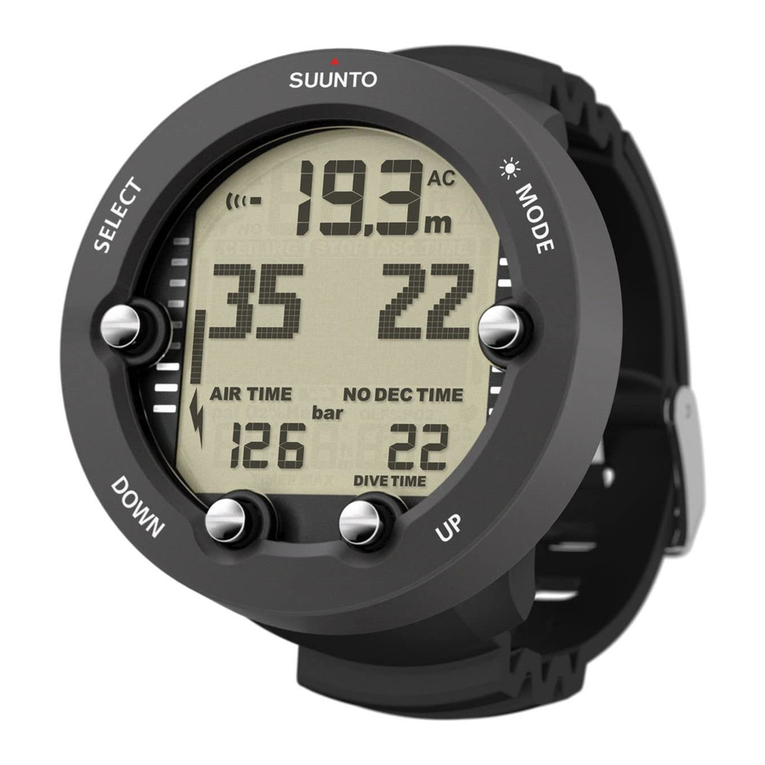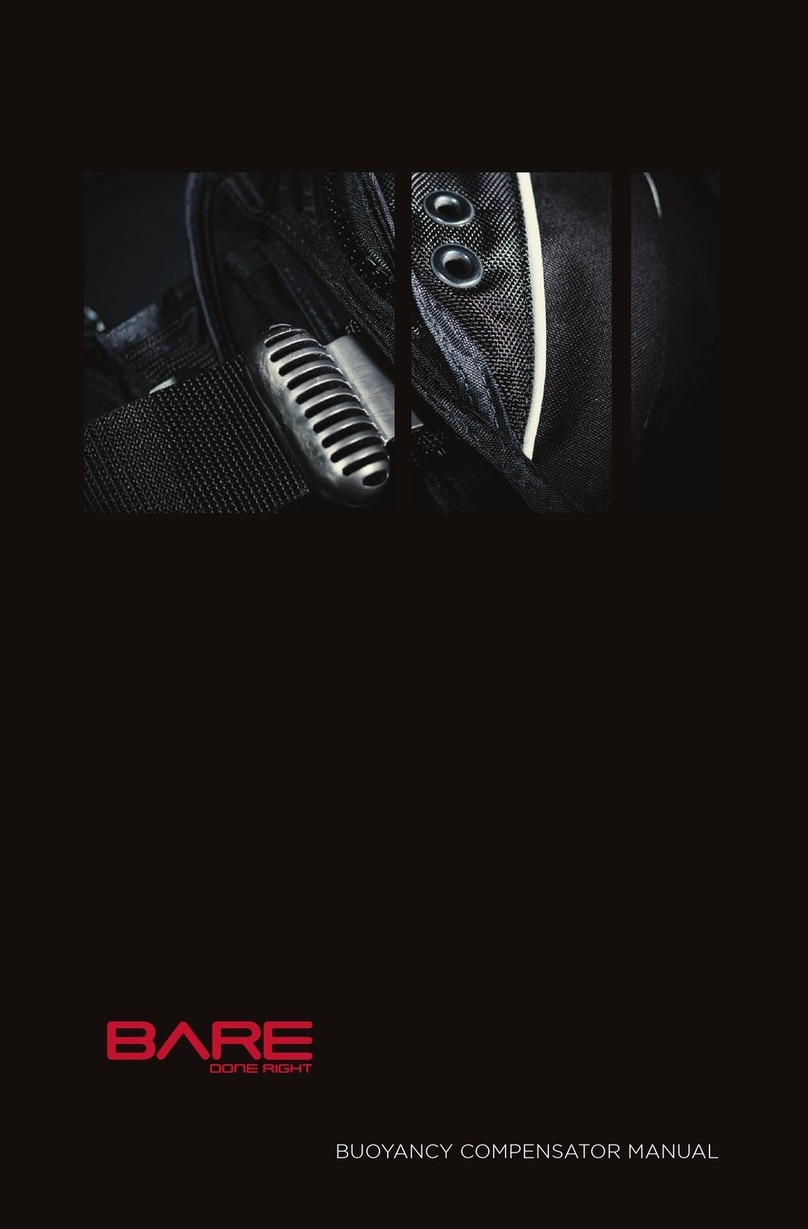Biomarine BioPak 240 REVOLUTION User manual

BioPak 240R-NIOSH User Instruction Manual
47C090, Revision C
Page 1 of 25
BioPak 240R-NIOSH
Closed-Circuit, Self-Contained Breathing Apparatus
User Instructions
47C090, Revision C
April 2018

BioPak 240R-NIOSH User Instruction Manual
47C090, Revision C
Page 2 of 25
CERTIFICATION APPROVALS 3
Respirator NIOSH Approval Label 3
OrbSorb®CO2Scrubber NIOSH Approval Label 4
RMS MSHA Electrical Approval 4
CAUTIONS AND LIMITATIONS 5
S-SPECIAL OR CRITICAL USER’S INSTRUCTIONS 5
1. INTRODUCTION 8
1.1 Breathable Oxygen 8
1.2 Apparatus Duration 8
1.3 Personnel Training 8
1.4 Servicing 8
1.5 Spare Parts 9
2. APPARATUS DESCRIPTION 10
2.1 General 10
2.2 Harness 10
2.3 Housing 10
2.4 Breathing Loop 10
2.5 Oxygen Delivery System 11
2.6 Oxygen Cylinder 11
2.7 Alarming System 11
2.8 Facemasks 12
2.9 Optional Attachments 13
3. PREPARATION FOR USE 14
3.1 Maintenance Tag Inspection 14
3.2 Mask Preparation 14
3.3 BioPak Positioning 14
3.4 PCM Installation 14
3.5 Carbon Dioxide Scrubber Installation 14
3.6 Breathing Chamber Lid Installation 15
3.7 Coolant Canister Installation 16
4. DONNING THE APPARATUS 16
4.1 Attachment of Cap Lamp Battery and/or Self-Rescuer 16
4.2 Donning the Apparatus 17
4.3 Donning the Facemask 17
4.4 Activate Oxygen Supply 18
5. PRACTICAL USE 20
5.1 Breathing the Apparatus 20
5.2 Speaking 20
5.3 Alarming System 20
5.4 Coolant Replacement 20
5.5 Emergency Bypass 20
5.6 Emergency Operation 20
5.7 Low Temperature Operation 21
5.8 Facemask Fogging 21
6. DOFFING THE APPARATUS 21
6.1 Doffing Instructions 21
7. APPARATUS SPECIFICATIONS 22
8. WARRANTY 23
Revision Record 24

BioPak 240R-NIOSH User Instruction Manual
47C090, Revision C
Page 3 of 25
CERTIFICATION APPROVALS
Respirator NIOSH Approval Label:
CAUTIONS AND
LIMITATIONS
2
JMNOS
JMNOS
JMNOS
PRO PP
Hydration System Kit
043703
X
PRO PP Fa ce p i ecce
Spectacle Kit
B47C075
X
AVIWT Communication
I nte rfa ce
027341
X
X
Spray-On Anti-Fog B47C015
X
X
X
AV3000/AV3500
Hydration System Kit
D47C033
X
X
AV3000/AV3500 Fa cepi ece
Spectacle Kit
D47C022
X
X
Facepiece
Magnetic Wiper
C47C017
X
X
X
MONITORING
SYSTEM
RMS D47C016
X
X
X
OTS Flame-Rated 47C092
X
X
X
Flame-Rated D47C014-02
X
X
X
Non-Flame-Rated D47C014-01
X
X
X
PRO PP Me di u m
wi th D ri nk Po rt
043671-04
X
PRO PP Me di u m 043671-03
X
PRO PP Sma l l
wi th D ri nk Po rt
043671-02
X
PRO PP Sma l l 043671-01
X
AV3500 La rge D47C054-03
X
AV3500 Me di um D47C054-02
X
AV3500 Sma ll D47C054-01
X
AV3000 La rge D47C013-03
X
AV3000 Me di um D47C013-02
X
AV3000 Sma ll D47C013-01
X
INTERNAL HEAT
EXCHANGER
PCM C47C019
X
X
X
International,
O-Ring Seal
D47C087-02
X
X
X
No rth Ame ri ca n,
O-Ring Seal
D47C087-01
X
X
X
International,
BODOK Sea l
D47C012-02
X
X
X
No rth Ame ri ca n,
BODOK Sea l
D47C012-01
X
X
X
HEAT EXCHANGER Ice Canister C47C011
X
X
X
CARBON DIOXIDE
ABSORBENT
OrbSorb ® D47C055
X
X
X
CENTER SECTION D47C009
X
X
X
PN EUMAT I C
ASSEMBLY
D47C008
X
X
X
UPPER HOUSI NG D47C007
X
X
X
LOWER HOUSING D47C006
X
X
X
BREATHING HOSE D47C005
X
X
X
PROTECTION
1
240-MIN/3000 PSIG/SC/PD
240-MIN/3000 PSIG/SC/PD
240-MIN/3000 PSIG/SC/PD
TC-
13F-541
13F-684
13F-959
THESE RESPIRATORS ARE APPROVED ONLY IN THE FOLLOWING CONFIGURATIONS:
ACCESS ORIES
ALTERNATE
HARNESS ASSEMBLY
ALTERNATE FULL FACEPIECE
ALTERNATE OXYGEN
CYLINDER
RESPIRATOR COMPONENTS
BIOMARINE INCORPORATED, A WHOOLY OWNED SUBSIDERARY OF NEUTRONICS INC.
456 CREAMERY WAY, EXTON, PA, 19341-2532 USA
PHONE: (610) 524-8800 FAX: (610) 524-8807 WEB: www.NeutronicsInc.com
BioPak 240R
CLOSED-CIRCUIT, PRESSURE-DEMAND, ENTRY AND ESCAPE, SELF-CONTAINED BREATHING APPARATUS
S-Special or critical User's Instructions and/or specific use limitations apply. Refer to User's Instructions before donning.
1 PROTECTION
PD-Pressure-Demand SC-Self-Contained
2 CAUTIONS AND LIMITATIONS
A47C003DLj
rev. j [march 2018]
J-Failure to properly use and maintain this product could result in injury or death.
M-All approved respirators shall be selected, fitted, used and maintained in accordance with MSHA, OSHA and other applicable regulations.
N-Never substitute, modify, add or omit parts. Use only exact replacement parts in the configuration as specified by the manufacturer.
O-Refer to User's Instructions, and/or maintenance manuals for information on use and maintenance of these respirators.

BioPak 240R-NIOSH User Instruction Manual
47C090, Revision C
Page 4 of 25
Orbsorb® Carbon Dioxide Chemical Scrubber NIOSH Approval Label:
Remote Monitoring System (RMS) MSHA Electrical Approval:
Eveready, Inc. Energizer # 522
or Duracell, Inc. # MN1604
following 9-Volt batteries only:
MSHA approved for use with one of the
to Biomarine BP240R Breathing
The connectors can only be connected
Rayovac Corp. # A1604
Panasonic Industrial Co. # 6AM6
MSHA Approval No: 18-A060028-0
BIOMARINE - NTRON, INC.
Tested for intrinsic safety in methane-air
456 Creamery Way, Exton, PA 19341 USA
Permissible Pressure and Temperature
Mine Safety and Health Adminstration
United States Department of Labor
The battery is to be changed in
Apparatus.
Warnings:
fresh air only.
mixtures only.
Monitoring Device
Model: RMS

BioPak 240R-NIOSH User Instruction Manual
47C090, Revision C
Page 5 of 25
CAUTIONS AND LIMITATIONS
J - Failure to properly use and maintain this product could result in injury or death.
M - All approved respirators shall be selected, fitted, and maintained in accordance with NIOSH,
MSHA, OSHA, and other applicable regulations.
N - Never substitute, modify, add, or omit parts. Use only exact replacement parts in the
configuration as specified by Biomarine.
O - Refer to User’s instructions, and/or maintenance manuals for information on use and
maintenance of these respirators.
S - Special or Critical User’s Instructions and/or specific use limitations apply. Refer to User’s
instructions before donning.
S – Refer to the AVIWT Communication Interface User Instructions and MSHA Conditions of Use
for Sentinel Mesh Handset documents to ensure that intrinsic safety approval is maintained
when utilizing the optional communication system of section 2.9.
S-SPECIAL OR CRITICAL USER’S INSTRUCTIONS
Please Read Carefully and Fully Understand
•All users of the Self-Contained Breathing Apparatus (SCBA) must be trained by Biomarine
Qualified Instructors in the donning, operation, inspection and emergency use procedures of
the BioPak 240R.
•Biomarine, or a qualified Biomarine representative, must perform all repairs beyond the
scope of this manual.
•Prior to using the BioPak 240R it must be determined that the user is medically fit. The
following lists some, but not all, medical and psychological conditions that could limit or
prevent the use of the BioPak 240R.
Emphysema Chronic Obstructive Pulmonary Disease
Bronchial Asthma X-Ray evidence of Pneumonia
Evidence of reduce pulmonary function Coronary Artery Disease
Severe or progressive hypertension Epilepsy-Grand Mal or Petit Mal
Pernicious Anemia Diabetes-Insidious or Mellitus
Breathing difficulties when wearing a SCBA Abnormal or ruptured ear drum
Claustrophobia or anxiety when wearing a SCBA Pacemaker or other Cardiac Conditions
•Compressed Oxygen Hazard: Always handle oxygen cylinders with care to prevent
damage. Do not allow oil, grease or other foreign materials to come in contact with cylinder,
cylinder valve or cylinder pressure regulator to prevent possible ignition. Do not open the
cylinder valve in the presence of open flame, sparks or high radiant heat. Failure to follow
these recommendations could result in personal injury or death.
•Oxidizing Agent Hazard: Oxygen will enhance the combustion of other materials so that
materials that normally will not burn in air may burn in oxygen-rich atmospheres; and,
materials that do burn in air will burn more vigorously and at a higher temperature in oxygen-
rich atmospheres. Oxygen will not cause materials to ignite without the presence of an
ignition source.
•Work Load Stress Factors: The use of a SCBA will add to the work load and stress of the
user. The user must be capable of determining when excessive ambient temperatures and
high workloads will lead to physical exhaustion and/or collapse.
•Low Temperature Operation: The BioPak 240R is suitable for respiratory protection during
entry into and escape from oxygen deficient atmospheres in temperatures as low as -5oF

BioPak 240R-NIOSH User Instruction Manual
47C090, Revision C
Page 6 of 25
(-20oC) providing: 1) If the BioPak is stored in low temperatures it must be fully dry and
NOT have the carbon dioxide scrubber pre-packed into the breathing chamber; and 2) the
carbon dioxide scrubber is stored at temperatures above 32oF (0oC) and is only installed into
the BioPak just prior to use. Prior to donning a cold BioPak, verify that the cylinder is securely
connected to the pressure regulator.
•The BioPak 240R is approved only with the oxygen cylinder fully charged with compressed
medical or aviation grade oxygen with moisture content less than 50 mg/m3at 3000 psi (207
bar). Allow the oxygen cylinder to cool after filling to determine the correct pressure. Do not
substitute any other gas type for the specified oxygen. The user bears full
responsibility for the purity of oxygen contained in the BioPak 240R oxygen cylinder.
The use of non-approved gasses can result in injury or death. If the oxygen cylinder is
improperly filled with any gas other than oxygen, the cylinder must be replaced. A
foreign gas may cause cylinder corrosion.
•Always check the BioPak 240R oxygen cylinder for a current hydrostatic test date. DOT
requires carbon fiber wrapped, aluminum cylinders be tested by an approved facility on a 5-
year cycle from the date of manufacture. Cylinder inspections by the user as outlined in CGA
6.2 must be done on a regular basis.
•Prior to each use of the BioPak 240R, a fully charged oxygen cylinder, a fresh charge of
carbon dioxide absorbent, frozen ice canisters, moisture control sponges and the phase
change module (PCM) must be installed.
•After each use of the BioPak 240R, a thorough cleaning and disinfection of the facemask,
breathing hoses and breathing loop must be completed in accordance with procedures
provided in this manual.
•Use with adequate skin protection when worn in atmospheres that contain gases or vapors
that poison by skin absorption (for example hydrocyanic acid gas).
•Do not use an unapproved facemask. Use only the facemasks approved for the BioPak
240R. An unapproved facemask will compromise the protection provided to the user by the
BioPak 240R. A good facemask seal is important to achieving full protection and duration.
Users must conform to MSHA/NIOSH guidelines concerning facial hair and use of the
facemasks. A clean-shaven user will significantly increase the chances of achieving an
adequate face seal.
•The on-going effectiveness and reliability of any protective breathing equipment is dependent
upon the user/owner’s standard of care in maintaining the equipment and the user’s expertise
in using the equipment.
•Personnel who intend to use protective breathing equipment in a dangerous atmosphere
must have the proper training, temperament and experience to be able to function safely.
•The user shall periodically inspect the TRIM display as described in this manual to determine
the status of the respirator oxygen supply.
•Intrinsic Safety Consideration for Model/Type RMS permissible Pressure and
temperature Monitoring Device:
•Read manual before use.
•The connectors of the monitoring device may only be connected to a Biomarine
BioPak 240R Breathing Apparatus oxygen regulator, manifold block and breathing
chamber. The fiber optic cable may only be connected to the BioPak 240R remote
gauge assembly.
•Tested for intrinsic safety in methane-air mixtures only.
•The battery is to be changed in fresh air only. Do not change battery in hazardous
areas. Approved for use only with the battery types specified in this manual.

BioPak 240R-NIOSH User Instruction Manual
47C090, Revision C
Page 7 of 25
•The use of the carbon dioxide chemical scrubber must always include the installation of the
moisture pad provided with the scrubber. Failure to install the moisture pad as described in
this manual can lead to scrubber flooding and elevated inhalation concentrations of carbon
dioxide that may lead to injury or death.
•Carbon Dioxide Chemical Scrubber: Users ARE NOT permitted to mix versions of the
OrbSorb®within a BioPak. Scrubber canisters installed into the BioPak for use must be of
exactly the same shape and type.
DISCLAIMER
This manual presents the minimum recommended procedures for maintaining the BioPak
240R. End users are free to implement additional procedures and tests above and beyond
the scope of this manual as they see fit or as may be required for specific locations or
applications, provided these procedures meet all criteria presented in the manual.
Failure to follow the minimum procedures presented in this manual may violate
government or agency approvals as well as void the manufacturer’s warranty.
Contact Biomarine with any questions pertaining to customized procedures or questions
concerning the procedures stipulated in this manual.

BioPak 240R-NIOSH User Instruction Manual
47C090, Revision C
Page 8 of 25
1. INTRODUCTION
1.1 Breathable Oxygen
Oxygen used to supply or charge the
breathing apparatus must be medical or
aviation grade oxygen with moisture content
less than 50 mg/m3at 3000 psi (207 bar).
The composition of suitable oxygen is given
below and provides the maximum level of
contaminates in the source oxygen
acceptable for use in the BioPak.
Oxygen: 99.5% minimum mole
Carbon Dioxide: 300 ppm maximum
Carbon Monoxide: 10 ppm maximum
The purity/quality of oxygen used in the
breathing apparatus should be tested
periodically in accordance with national
regulations.
National regulations must be observed.
Personnel dealing with compressed oxygen
and compressed oxygen cylinders must be
fully trained in the use and handling of
compressed oxygen.
1.2 Apparatus Duration
The apparatus will provide the user with 440
liters of compressed oxygen and has been
rated for a 4-hour duration according to
specifications in 42CFR84. Actual duration
of the apparatus may vary due to factors
such as:
•Workload: high work rates will
increase consumption rates of
oxygen.
•Facemask Seal: poor seal of mask
will result in system leaks and high
consumption rates.
•Physical Fitness of Wearer
•System Leaks: leaks in the BioPak
system will result in high oxygen
consumption and reduced BioPak
duration.
It is important that all wearers are aware of
the above factors and take account of them
when assessing BioPak duration.
It is equally important that all wearers
understand that the BioPak 240R respirator
is a positive-pressure apparatus. Leaks in
the apparatus itself or in the seal between
the wearer’s face and the facemask will lead
to the apparatus adding additional oxygen to
maintain positive pressure.
1.3 Personnel Training
Personnel who use closed-circuit, self-
contained, positive-pressure, compressed
oxygen breathing apparatus must be fully
trained in accordance with these
instructions, local and national regulations.
These instructions cannot replace an
accredited training course provided by
qualified instructors in the proper and safe
use of Biomarine breathing apparatus.
Please contact Training & Technical
Support Services or your local distributor
for training course details.
Training & Technical Support Services:
Biomarine Inc.
456 Creamery Way
Exton, PA 19341
United States of America
Tel: +1 610.524.8800
Fax: +1 610.524.8807
Web: www.BioPak 240R.com
1.4 Servicing
The BioPak 240R must be serviced at
scheduled intervals by qualified benchmen
personnel who have completed a formal
training course and hold a current certificate
for the service and repair of Biomarine
breathing apparatus.
Turn Around Maintenance shall be
performed after each use of the BioPak
240R as detailed in the BioPak 240R
Benchman Manual.
Long Term Maintenance must be
performed on a monthly basis, if the BioPak
is in constant use; or, on a quarterly basis if
the BioPak is being used less than once per
month, as defined in the BioPak 240R
Benchman Manual.
Electronics Intrinsic Safety Assessment
Procedure must be performed each time
the batteries are replaced in the alarming
system as defined in the BioPak 240R
Benchman Manual.
Benchman training and service contracts
can be provided by contacting Training &
Technical Support Services.

BioPak 240R-NIOSH User Instruction Manual
47C090, Revision C
Page 9 of 25
1.5 Spare Parts
Spare parts, accessories, general
information and factory service can be
obtained by contacting Training &
Technical Support Services.
Reference details are provided in the
BioPak 240R Benchman Manual
concerning spare part identification,
accessory identification and BioPak factory
service.
The BioPak 240R-NIOSH User and
Benchman manuals can be provided in
electronics format upon request.

BioPak 240R-NIOSH User Instruction Manual
47C090, Revision C
Page 10 of 25
2. APPARATUS DESCRIPTION
2.1 General
BioPak 240R is a closed-circuit, positive-
pressure, self-contained breathing
apparatus (CCBA) for use in long-duration
missions into atmospheres that are
immediately dangerous to life and health
(IDLH). Applications may include mine
rescue, fire-fighting, confined space entry,
domestic preparedness, military, tunnel
rescue and HAZMAT.
All versions of the BioPak 240R feature a
backpack-style housing that is worn over the
shoulders and hips of the wearer. A
pressure gauge is supplied to indicate
remaining stores of oxygen and two visual
alarms and one audible alarm is provided for
system status.
The closed-circuit design will recycle the
user’s exhalation breath by removing carbon
dioxide, replacing consumed oxygen,
trapping condensation and cooling the
breathing gas.
The positive-pressure design will maintain
internal breathing gas pressures slightly
above external atmospheric pressure. This
feature will provide increased protection
against the inward migration of external
toxins to the wearer.
All external housing components are static
dissipative and flame retardant.
The BioPak 240R is approved to the USA
standards illustrated by the approval labels
in the beginning of this manual.
2.2 Harness
The BioPak harness is padded to increase
wearer comfort. The flame-retardant
harness is manufactured from Kevlar™ and
Nomex™ materials with stainless steel
hardware. The harness is attached directly
to the apparatus via locking stainless steel
screws.
2.3 Housing
The backpack-style housing is injection
molded from a flame-retardant
polycarbonate/stainless steel alloy that is
lightweight, high-strength and static-
dissipative. The housing consists of a lower
portion and an upper portion that snap
together in a secure fashion without the
need for connection hardware.
2.4 Breathing Loop
The breathing loop consists of the breathing
chamber, breathing hoses, facemask
connector and facemask.
The breathing chamber consists of the
center section, center section lid and
diaphragm. The spring loaded diaphragm
maintains positive pressure within the
apparatus. All oxygen additions will occur
within the breathing chamber as well as over
pressure venting. Carbon dioxide is
removed from exhalation gas by the carbon
dioxide scrubbers located within the
breathing chamber. Excessive moisture will
be retained by the moisture containment
sponges located within the center section.
Inhalation gas cooling is achieved as the
gas travels around the two coolant canisters
of the breathing chamber and past the
Internal phase change module (PCM)...

BioPak 240R-NIOSH User Instruction Manual
47C090, Revision C
Page 11 of 25
2.5 Oxygen Delivery System
Oxygen is delivered from the oxygen
cylinder to the breathing loop through a
pressure regulator and manifold system in
one of three different methods.
Pressure demand oxygen additions are
provided whenever the diaphragm of the
breathing chamber reaches the upper level
of its travel and depresses the demand
valve plunger. Additions will be made at
rates up to 80liters/minute whenever the
demand valve plunger is depressed.
Pressure demand additions occur whenever
the wearer consumes more oxygen than is
supplied by the constant add.
Constant add oxygen additions are
continually added to the breathing loop at an
average rate of 1.8 liters/minute. This
oxygen addition rate is equivalent to the
oxygen consumption rate of a wearer at a
moderate work rate.
Emergency add oxygen additions occur
whenever the wearer depresses and holds
the red emergency bypass button. The
emergency add will provide 80-100
liters/minute of oxygen flow and is utilized
only for emergency situations.
2.6 Oxygen Cylinder
The oxygen cylinder is a fully wrapped
aluminum carbon fibre composite cylinder
that is secured into the apparatus via
connection to the pressure regulator and a
hold down strap. The cylinder will provide
containment of the oxygen supply at 3000
psi (207 bar) to provide 440 liters of
breathable oxygen to the wearer.
2.7 Alarming System
The alarming system consists of a
pneumatic pressure gauge and an electronic
monitor to provide the wearer with
independent and redundant system status
indications.
The pressure gauge is mounted on the
harness and retained by a snap strap and
magnet. Remaining stores of oxygen will be
indicated on the gauge and a red band of
color will indicate to the wearer when
oxygen stores have reached 20-25% of
capacity. The pressure gauge is protected
against sudden loss of oxygen stores in the
event of gauge line severing by a manual
disconnect located at the gauge pass
through point of the housing.
The electronics monitor will provide the
wearer of indications of system status as
listed below through the LED located on the
pneumatic pressure gauge and via an alarm
horn located on the monitor package.
Condition Alarm Action
System Ok Flashing Green
System Fault Flashing Red
Horn Sounding
End of Service Life Flashing Red
(Low Oxygen) Horn Sounding
Ice Reminder Flashing Blue
Low Battery Flash Red, Green,
Blue
Horn Sounding

BioPak 240R-NIOSH User Instruction Manual
47C090, Revision C
Page 12 of 25
2.8 Facemasks
BioPak 240R is approved for use with the
AV3000, AV3500 and PRO PP full
facemask, which conforms to NIOSH
requirements for use with a SCBA.
The AV3000 mask is supplied through
special order only.
All facemasks are provided with five-point,
fully adjustable head harnesses and require
no use of Anti-Fogging agents due to a
permanently mounted anti-fog film. Speech
diaphragms are provided to allow verbal
communication and all masks are provided
with a magnetic wiper that is for optional
user utilization.
The polycarbonate visor of all masks
conforms to GGG-M-125d for impact
resistance.
Note that in order to utilize the optional PRO
PP Drink System (hydration system) the
PRO PP mask must be modified by the
factory. Field retrofitting of the facemask for
the drink system is not available.
AV3500 Mask
PRO PP Mask

BioPak 240R-NIOSH User Instruction Manual
47C090, Revision C
Page 13 of 25
2.9 Optional Attachments
•Hydration systems provide the
wearer with a source of drinking
water without breaking the seal of
the breathing loop to the external
atmosphere.
•Kevlar™ breathing hose covers
provide additional abrasion
protection to breathing hoses.
•Radiant heat guards provide
additional breathing hose protection
against high radiant heat and direct
flame contact.
•Communication system will provide
a mask-mounted microphone, lapel
speaker and interface cable to an
Innovative Wireless Technologies
(IWT) intrinsically safe
communication system.

BioPak 240R-NIOSH User Instruction Manual
47C090, Revision C
Page 14 of 25
3. PREPARATION FOR USE
Prior to donning the apparatus the wearer
shall conduct the following procedures to
ready the apparatus for use.
3.1 Maintenance Tag Inspection
Locate and inspect the maintenance tag that
should be attached to the apparatus. Verify
that all items on the tag are properly dated
and initialed. If the maintenance tag is
missing or not properly completed the
apparatus MUST NOT be placed into
service until full turn around
maintenance has been completed as
specified in the BioPak 240R Benchman
Manual.
3.2 Mask Preparation
The AV3500 or PRO PP mask DOES NOT
require the application of anti-fogging agents
of any kind.
If the optional magnetic wiper is utilized,
soak both chamois surfaces of the wiper
pieces with water and install onto the lens of
the facemask so that the chamois side of
each piece is in direct contact with the lens.
3.3 BioPak Positioning
Prop the BioPak to a level position as
depicted above. This provides for greater
ease of work on the BioPak.
3.4 PCM Installation
Install the PCM canister into the center
section between the two scrubber locations
as shown below.
3.5 Carbon Dioxide Scrubber Installation
Inspect the “use by date” of the carbon
dioxide scrubber to ensure that it is current.
Record the carbon dioxide scrubber serial
number and “use by date” date onto the
maintenance tag or affix the scrubber label
to the back of the tag.

BioPak 240R-NIOSH User Instruction Manual
47C090, Revision C
Page 15 of 25
Open the sealed bag and inspect each
canister to verify the presence of an o-ring
properly seated into the lower groove.
Position each canister into the center
section as depicted below.
After installation, verify that the o-ring of
each canister is fully seated into the cup of
the center section.
Remove the moisture pad from the sealed
bag and install it into the lower section of the
breathing chamber as shown below.
WARNING: Failure to install the moisture
pad will result in scrubber flooding and
caused elevated carbon dioxide levels in
the inhalation gas that could lead to
injury or death.
WARNING: Users ARE NOT permitted to
mix versions of the OrbSorb® carbon dioxide
scrubber within a BioPak. Scrubber
canisters installed into the BioPak must be
of exactly the same shape and type.
3.6 Breathing Chamber Lid Installation
Verify that the large o-ring of the breathing
chamber is properly lubricated. Install the lid
onto the top of the breathing chamber
making sure to properly align. Secure the lid
into position by locking the eight (8) slide
locks over the studs.

BioPak 240R-NIOSH User Instruction Manual
47C090, Revision C
Page 16 of 25
3.7 Coolant Canister Installation
Remove the coolant lids from the center
section lid and insert a fully frozen ice
canister into each location. Replace the
coolant lids.
Recommended Safe Duration with
Respect to Ambient Temperatures
Recommended apparatus duration of use:
Ambient Recommended
Temperature Safe Duration
105 to 140oF 1-hour
(41 to 60oC)
141 to 194oF 15-minutes
(61 to 90oC)
+194oF 6-minutes
(+90oC)
4. DONNING THE APPARATUS
4.1 Attachment of Cap Lamp Battery
and/or Self Rescuer
The harness provides for the optional
connection of a cap lamp battery pack and a
self-rescue device to the waist belt. If the
user is not going to connect such
devices to the harness, the attachment
components should be removed from the
harness to prevent snagging.
1. Remove the mounting strap from the
harness by unclipping the hooks.
2. Slide the mounting strap behind the belt
mounts of the device as depicted above.
3. Connect the device to the harness by
clipping the hooks to the eyelets of the
mounting strap.

BioPak 240R-NIOSH User Instruction Manual
47C090, Revision C
Page 17 of 25
4.2 Donning the Apparatus
Specialist Users (such as Emergency
Services) may operate alternative donning
procedures that conform to the relevant
statutory regulations.
1. Check that the shoulder and waist
harness straps are fully extended.
2. Put the apparatus on back.
3. Bend over and pull down on the two
shoulder strap adjustments to position
the apparatus on the shoulders.
4. Connect the waist belt straps together
and pull the adjust strap to snug the
apparatus to the hips.
5. Connect and adjust the harness chest
strap.
6. Position and secure the pressure gauge
to the shoulder strap.
7. Flip the breathing hoses over the
shoulders and secure hose to the
harness using the hose straps.
Position of the hose straps should be
rearward for optimal head movement.
The apparatus can be adjusted to rest either
on the hips or shoulders of the wearer by
adjustment of the shoulder straps.
4.3 Donning the Facemask
The donning procedure is identical for
the AV3500 or PRO PP mask types.
1. Check that the head harness straps are
fully slackened.
2. Hold the head-harness lower straps,
place chin in chin-cup and pull straps
over back of head, brushing hair away
from faceseal.

BioPak 240R-NIOSH User Instruction Manual
47C090, Revision C
Page 18 of 25
3. Adjust the facemask top strap so that
the mask is at the correct level with the
face and the head-harness pad is in the
center of the back of the head, then
tighten harness straps in sequence,
Bottom, Middle, Top. DO NOT over-
tighten.
4. Depress the push button of the
facemask front port and insert the
breathing hose adapter into the port.
Release the push button and tug and
the breathing hose adapter to ensure
that it securely anchored.
4.4 Activate Oxygen Supply
1. Slowly turn the green oxygen knob
located on the right side of the
apparatus house to its full
counterclockwise (rearward) position.
2. Watch the pressure gauge and LED.
The pressure gauge shall read a
minimum of 3000 psi (207 bar) pressure
to achieve full apparatus duration. The
LED shall initially flash RED, GREEN,
BLUE with the horn sounding. The LED
shall then flash GREEN to signal
acceptable system status. If after 5-10
minutes of operation the LED flashes
BLUE,this is a reminder to check that
the coolant canisters have been
installed. This is a self-cancelling alarm
that will return the LED to flashing
GREEN after 5-minutes.
DO NOT place the apparatus into service if
the pressure gauge or LED is not functioning
as described above or if the LED is flashing
RED; or, if the LED is not flashing at all; or if
the LED is not flashing GREEN.
3. Exhalation Check Valve Test: With
two hands collapse the inhalation hose
and inhale. Proper sealing of the
exhalation check valve will result in the
facemask being pulled in toward the
face.
4. Inhalation Check Valve Test: With two
hands collapse the exhalation hose and
exhale. Proper sealing of the inhalation

BioPak 240R-NIOSH User Instruction Manual
47C090, Revision C
Page 19 of 25
check valve will result in the facemask
being pushed away from the face.
DO NOT place the apparatus into service if
the check valves do not pass the tests of
steps 3 and 4.
5. Depress the red emergency bypass for
1-2 seconds and release. Verify the
sound of oxygen gas additions into the
breathing chamber while the button is
depressed and that the oxygen
additions cease when the button is
released.
DO NOT place the apparatus into service if
the emergency bypass valve does not pass
the above test.

BioPak 240R-NIOSH User Instruction Manual
47C090, Revision C
Page 20 of 25
5. PRACTICAL USE
5.1 Breathing the Apparatus
There is no need to accelerate or deepen
normal breathing rates. The apparatus will
automatically adjust oxygen additions to
match the needs of the user.
5.2 Speaking
The facemasks are provided with speaking
diaphragms that transmit sound from the
interior of the facemask to the external
surrounding environment. Speak slightly
louder and slower than normal making every
effort to clearly pronounce words. Do not
shout.
Optional voice amplification devices can be
attached to the facemask prior to donning to
enhance clarity of speech. Contact
Biomarine or your local distributor for
details and supply.
Reference system manuals for optional
microphones and communication
systems that may be employed with the
BioPak.
5.3 Alarming System
The wearer must frequently inspect the
pressure gauge and LED throughout the
duration of the mission.
Should the pressure gauge indicate
pressure in the RED colored area of the
gauge, the end of service life of the
apparatus is near; and, the wearer shall
retire to a safe location as quickly as
possible to doff the apparatus.
Should the LED flash RED and/or the horn
sounds, the wearer shall retire to a safe
location as quickly as possible to doff the
apparatus.
Should the LED cease to flash or is not
flashing GREEN, the wearer shall retire to a
safe location as quickly as possible to doff
the apparatus.
5.4 Coolant Replacement
If the breathing air becomes uncomfortable
to the wearer the ice canisters can be
replaced without doffing the apparatus or
breaking into the breathing loop.
Replacement of the ice canisters while
wearing the apparatus will require
assistance.
1. Remove the coolant covers from the
breathing chamber lid.
2. Remove the spent ice canisters from the
breathing chamber lid.
3. Install replacement, frozen coolant
canisters into the breathing chamber lid.
4. Replace the coolant lids on the
breathing chamber lid positioning the lid
handles vertically.
5.5 Emergency Bypass
The emergency bypass is for emergency
use only.
DO NOT attempt to use the emergency
bypass to cool the breathing gas or clear the
facemask of fogging.
Depress in 1-2 second periods for optimal
use.
Continued use of the emergency bypass will
shorten apparatus duration.
5.6 Emergency Operation
Follow the procedures below in event of the
described emergency situation.
Equipment Failure
Should any component of the apparatus
experience a failure or should the apparatus
upper housing become dislodged, the
wearer shall immediately retire to safe
location to doff the apparatus.
Other manuals for BioPak 240 REVOLUTION
2
This manual suits for next models
1
Table of contents
Other Biomarine Diving Instrument manuals


